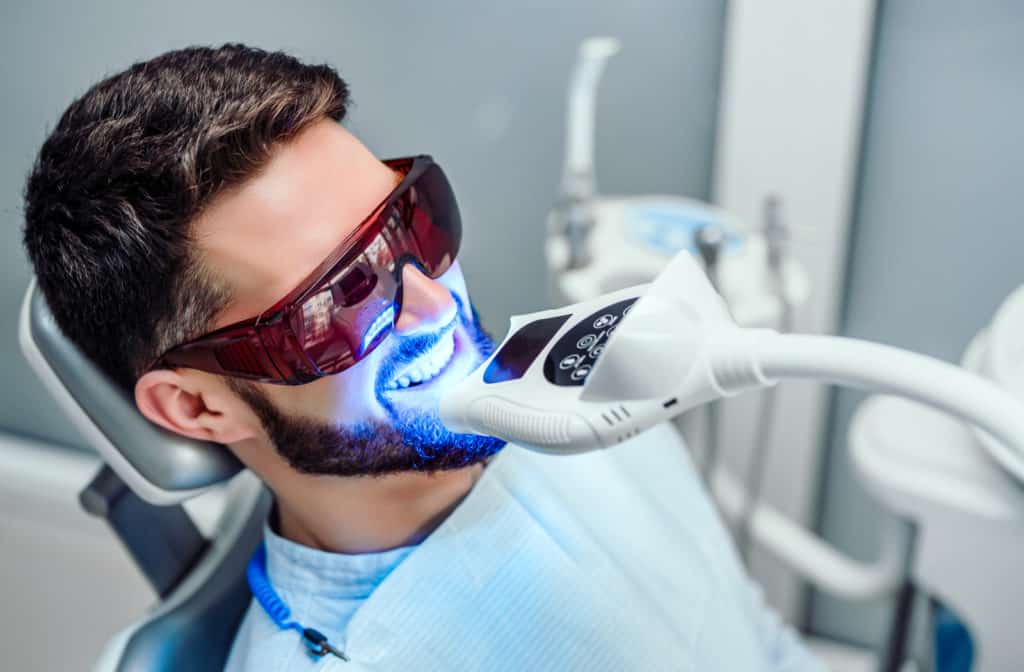Teeth Whitening: Facts, Types, and Products That Work
There are many different ways to treat discoloured teeth and make them brighter. Through the safe use of whitening trays, in-office bleaching, and surface stain removers like whitening toothpaste, you can achieve a whiter smile. It is always important to consult with your dentist before choosing the appropriate whitening method for your teeth.
How Does Teeth Whitening Work?
Teeth whitening is a fairly simple process that involves using bleaching agents to remove stains from the surface of your teeth. Whitening products contain one of two tooth bleaches — hydrogen peroxide or carbamide peroxide. These bleaches break stains into smaller pieces, which will brighten the look of your teeth and make them less discoloured.
Is it Safe to Whiten My Teeth?
Teeth whitening products and procedures are safe, but not all kinds of teeth are safe to whiten. It is important to consult with your dentist about the current state of your teeth before choosing to whiten them, as whiteners may not correct all types of discoloration.
Types of Teeth Whitening Procedures & Products
If you are chosen as a candidate for teeth whitening after talking to your dentist, there are four main ways to go about whitening your teeth:
Stain Removal Toothpaste
Every kind of toothpaste helps remove surface stain through mild abrasives that scrub the teeth. Whitening toothpastes have additional polishing agents that contain finer abrasives than normal toothpaste. These products are safe for your teeth and are very effective at removing surface stains. Unlike bleaches, these types of toothpaste do not change the colour of your teeth due to the polishing only happening at a surface level.
In-Office Bleaching
This procedure will require a visit to your dentist’s office. The dentist will apply either a protective gel to your gums or a rubber shield to protect your gums, then will commence the procedure of bleaching your teeth to remove stains.
At-Home Bleaching Trays
If you want to whiten your teeth at home, you can ask your dentist to provide you with a custom-made whitening tray. Your dentist will give you detailed instructions on how to use the bleaching solution with the tray and will explain to you how long the tray should be left on your teeth during each use. Whitening trays are an excellent alternative for people who want to whiten their teeth from home at a slower pace.
Usually, whitening trays will start to take their effect in anywhere from a few days to a few weeks.
Over-the-Counter Bleaching Products
Over-the-counter bleaching products such as toothpaste or whitening strips can be found at grocery stores and drug stores. These products have a lower concentration of bleaching agents compared to what your dentist would use in their office. It is still important to converse with your dentist first about if these products are safe to use for your teeth and specific teeth whitening needs.
Whitening Does Not Replace Brushing & Flossing
While teeth whitening can brighten your smile and boost your confidence, it cannot replace a healthy oral hygiene routine. Brushing and flossing regularly is just as important when you are using teeth whitening products as when you are not.

Why Teeth Change in Colour
Over time, your teeth can degrade and change in colour for a variety of reasons:
Food and Drink
Coffee, tea, and red wine are prone to staining your teeth. Many foods and drinks contain intense color pigments called chromogens that can attach to your enamel (the white, outer layer of your tooth).
Tobacco Use
Two chemicals found in tobacco create stains on your teeth: Tar and nicotine. Tar is naturally dark in colour and will darken the look of your teeth when you use tobacco products. Nicotine is colorless until it’s mixed with oxygen. After it contacts oxygen, nicotine turns into a yellowish, surface-staining substance.
Age
Below your enamel is a softer area called dentin. Over time, the outer enamel layer gets thinner with brushing and your dentin, which is a yellowish colour, will start to predominantly show through your teeth.
Trauma
If you’ve received an impact or injury in your mouth, your tooth may change color because it reacts to an injury by laying down more dentin.
Medications
Tooth darkening can be a side effect of certain antihistamines, antipsychotics, and high blood pressure medications. Young children who are exposed to antibiotics like tetracycline and doxycycline when their teeth are forming can end up having discoloured teeth later on in their life. Chemotherapy and head and neck radiation can also cause your teeth to darken.

